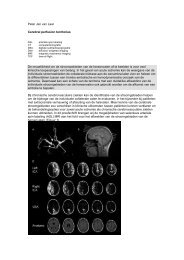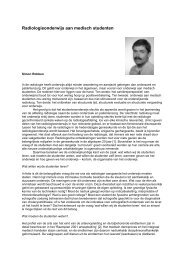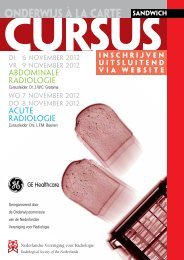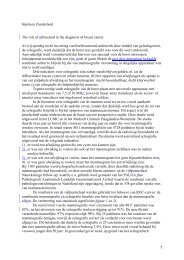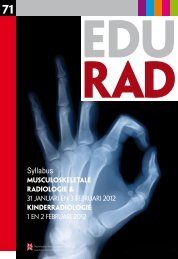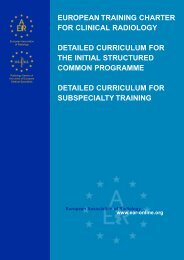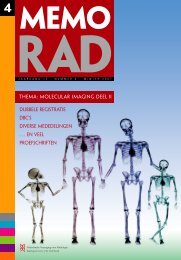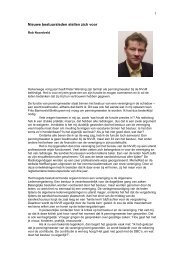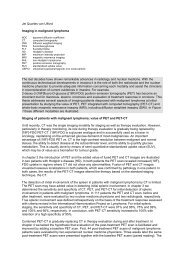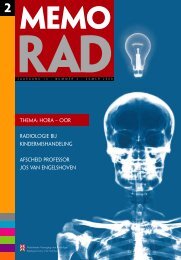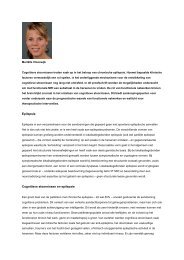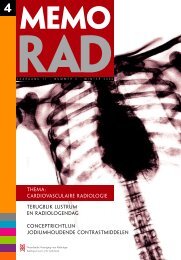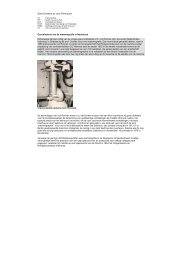programma & abstracts - Nederlandse Vereniging voor Radiologie
programma & abstracts - Nederlandse Vereniging voor Radiologie
programma & abstracts - Nederlandse Vereniging voor Radiologie
Create successful ePaper yourself
Turn your PDF publications into a flip-book with our unique Google optimized e-Paper software.
Mammadiagnostiek 1 4<br />
tly be visualized for evaluation in most patients.<br />
To date, 50 patients are evaluated: 3D-US evaluation of the<br />
breast shows a sensitivity of 88% and specificity of 97%,<br />
compared to MR imaging findings (and histology). In coming<br />
months all 201 patients will be evaluated.<br />
Conclusion: In our study so far, 3D-US shows high sensitivity<br />
and specificity in the detection of suspicious lesions compared<br />
to MRI. Automated breast volume scanning seems a promising<br />
new ultrasound technique in breast evaluation.<br />
O4.3<br />
MEDICOLEGAL CLAIMS FOLLOWING<br />
SCREENING MAMMOGRAPHY IN THE<br />
NETHERLANDS<br />
V. van Breest Smallenburg, W. Setz-Pels, F.H. Jansen,<br />
L.E.M. Duijm<br />
Catharina Ziekenhuis, Eindhoven<br />
Purpose: To determine the type and frequency of medicolegal<br />
claims at a Dutch breast cancer screening programme.<br />
Materials and methods: The study population consisted of<br />
all 80019 women who underwent screening mammography<br />
at a southern breast screening region of the Netherlands<br />
between January 1997 and July 2007 (301139 screens). We<br />
included all medicolegal claims that had been recorded at the<br />
central screening department within 3 years following screening<br />
mammography. During 2-year follow-up, we collected the<br />
biopsy results and surgery reports of all referred women. Two<br />
screening radiologists reviewed the screening mammograms<br />
of all screen detected cancers (SDC) and interval cancers (IC)<br />
and determined whether the cancer had been missed at the<br />
previous screen (in case of SDC) or latest screen (in case of<br />
IC). The radiologists were blinded to each others review; discrepant<br />
readings were followed by consensus reading.<br />
Results: Just 3 medicolegal claims had been reported,<br />
all of them related to financial compensation following a<br />
diagnosis of IC. The verdicts of these cases still have to be<br />
finalized. Excisional biopsy had been performed in 10.7%<br />
(234/2183) of false positive referrals. Review showed that<br />
20.8% (261/1254) of SDC had been missed at the previous<br />
screen and 23.6% (139/588) of IC should have been detected<br />
at the latest screen.<br />
Conclusions: Medicolegal claims were very rare, although<br />
a substantial proportion of false positive referred women<br />
had been confronted with excision biopsy and over 20% of<br />
cancers had been missed at the previous screen or latest<br />
screen, respectively.<br />
O4.4<br />
RADIOFREQUENCY-ASSISTED INTACT<br />
SPECIMEN BIOPSY OF BREAST TUMORS:<br />
AN EVALUATION ACCORDING TO THE<br />
IDEAL GUIDELINES<br />
S.C.E. Diepstraten 1 , H.M. Verkooijen 1 , P.J. van Diest 1 ,<br />
M.A. Fernandez-Gallardo 1 , K.M. Duvivier 1 , A.J. Witkamp 1 ,<br />
T. van Dalen 2 , W.P.Th.M. Mali 1 , M.A.A.J. van den Bosch 1<br />
1<br />
Universitair Medisch Centrum Utrecht, Utrecht<br />
2<br />
Diakonessenhuis, Utrecht<br />
Purpose: Radiofrequency-assisted intact specimen biopsy<br />
(RFIB) has been introduced for percutaneous biopsy or<br />
removal of breast tumors. Using radiofrequency cutting,<br />
the system enables the interventional radiologist to obtain<br />
an intact sample of the target lesion. According to IDEAL<br />
guidelines, we performed a critical evaluation of our initial<br />
experience with RFIB.<br />
Methods: Between June and November of 2010, X-ray guided<br />
RFIB was performed in 19 female patients. All patients<br />
presented with suspicious microcalcifications (BI-RADS<br />
III-V) on mammography. Biopsy specimen integrity, thermal<br />
damage and histological diagnosis were assessed by an<br />
expert breast pathologist. Data on technical success,<br />
diagnostic and therapeutic accuracy and peri-procedural<br />
complications were collected and analyzed according to the<br />
IDEAL guidelines.<br />
Results: Median age was 59 years. Median lesion diameter<br />
on mammography was 8 mm (range 2-76 mm). The procedure<br />
was successful in 17/19 (89%) patients and unsuccessful<br />
in 2/19 (11%) patients (1 nonrepresentative sample,<br />
1 sample with extensive thermal damage). Histological<br />
analysis of the RFIB specimen revealed 12/19 (63%) benign<br />
lesions and 7/19 (37%) malignancies (4 DCIS lesions and 3<br />
invasive ductal carcinomas). In 1 patient a DCIS lesion was<br />
completely removed with RFIB. Overall, 3 peri-procedural<br />
complications occurred (1 wound leakage, 1 arterial hemorrhage<br />
and 1 infection requiring oral antibiotics).<br />
Conclusion: Tissue sampling of suspicious breast lesions<br />
can be performed successfully with RFIB. In 1 patient DCIS<br />
was radically excised with RFIB, which illustrates its potential<br />
as a minimally invasive therapeutic procedure for removal<br />
of small breast tumors. This is an interesting focus for<br />
further research when larger probe sizes become available.<br />
1 6 E R A D I O L O G E N D A G E N - 2 9 e n 3 0 S E P T E M B E R 2 0 1 1<br />
35



